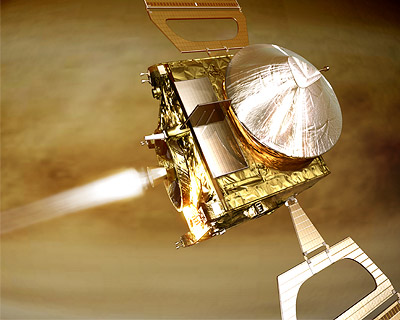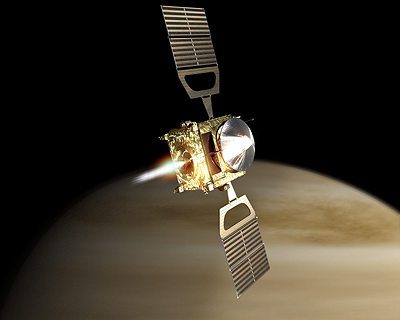Following the discoveries of Venus Express, the European Space Agency decided to allow the spacecraft to search for active volcanoes on Venus

The European spacecraft Venus Express, which was launched towards Venus in November 2005, measured with its instruments varying amounts of sulfur dioxide in the atmosphere. The scientists must now decide whether this is evidence indicating active volcanoes on the surface of Venus or whether it is an unknown mechanism affecting the upper atmosphere.
"Volcanoes are a key component of climate systems," says Fred Taylor, an interdisciplinary scientist on the Venus Express mission at the University of Oxford. The search for volcanoes was not defined as a central goal of the mission, however, volcanoes release gases such as sulfur dioxide into the atmosphere and hence their importance.
On Earth, sulfur compounds do not stay long in the atmosphere, instead they react with the soil. At first it was thought that the same thing happened on Venus, but it turned out that the reaction is much slower and it lasts 20 million years.
Previous missions to Venus found large amounts of sulfur dioxide. There were scientists who claimed that this was a sight indicating a volcanic eruption that occurred recently, on the other hand, others claimed that such an eruption could have occurred even 10 million years ago and the sulfur dioxide would still have remained in the atmosphere because it reacts very slowly with the rocks on the ground.

The new Venus Express observations show that there is a different amount of sulfur dioxide in the upper atmosphere, and this has reignited the debate. Since it is not known why there is a different amount than sulfur dioxide in the upper atmosphere, and to rule out the possibility of an alternative mechanism affecting the composition of the upper atmosphere, the European Space Agency decided to change the objectives of the mission and look for active volcanoes.
The SPICAV instrument is used by the spacecraft to study the atmosphere of Venus by analyzing the starlight and sunlight returning from the planet's atmosphere. Based on the reflected light, scientists know what atoms and molecules the atmosphere is made of. The technique only works in the upper atmosphere, above the clouds, at an altitude of 70-90 km. Within a few days, the amount of sulfur dioxide in this area dropped by two-thirds.
"I am very skeptical about the volcanic hypothesis," says Jean-Loup Biortx, a scientist who works on the SPICAV instrument, "However, I must admit that we still do not understand why there is such a high concentration of SO2 in the upper regions where it should have broken down on by the light of the sun, and why it changes wildly."
Another Bono Express device is the VIRTIS that can see through clouds at a height of 35-40 km in infrared frequencies. The device detects the signature of sulfur dioxide by analyzing the amount of infrared radiation the molecule absorbs. It appears that there is lower variability in the lower atmosphere, and according to the team of researchers, we have not seen a change greater than 40% on a global scale in the last two years.
The contradiction between the data led the agency to try to locate active volcanoes on the planet's surface and thus confirm (or refute) the volcano hypothesis. But it is not easy when it comes to a thick and cloudy atmosphere at an altitude of 100 km. To overcome the obstacles, the task force works in two ways, one is to locate areas with a high level of sulfur dioxide (indicative of a gas eruption from a volcano) and the second is to locate hot areas (indicative of lava coming out of a volcano).
So far, no active volcano has been found on the surface of the hostile planet, but the team continues its work and hopes to shed new light on our nearest neighbor.
For the press release of the Venus Express mission at the European Space Agency

One response
Great article Rami